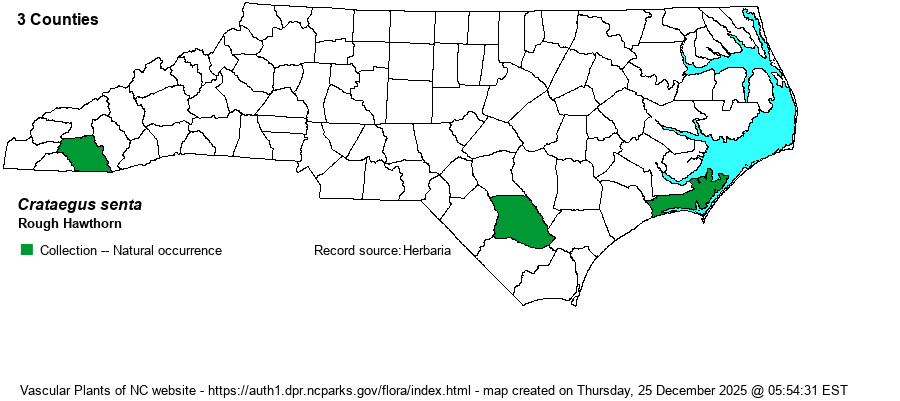| Author | Beadle | |
| Distribution | According to Lance's (2014) range map, it ranges over the southern half of the Coastal Plain, the southern half of the Piedmont, and barely into the extreme southern Mountains. The SERNEC database lists numerous collections from Buncombe County, but Lance (2014) has searched the general locations in that county without finding it, and specimens he examined are now named as the newly described C. lancei. However, the only remaining SERNEC specimens are from Carteret, Bladen, and Macon counties -- at either end of the state; thus, the species is certainly under-collected, and the range map below is quite incomplete.
Primarily found in the Coastal Plain and Piedmont from central NC south to northern FL and AL. A few records from the NC, SC, and GA mountains.
| |
| Abundance | Very poorly known. Lance (2014) calls it "rare", but Weakley (2018) suggests it may be uncommon in the Coastal Plain and rare in the Piedmont. The NCNHP lists it as Significantly Rare, but this is based just on the Buncombe records, which Lance (2014) has considered to be another species. NatureServe lists the species as an alarming G2, but this rank does not correspond well to the fairly wide range shown in Weakley (2024). The editors feel that it should have an extant rank of S1?, but the NCNHP gives it as SH (Historical). | |
| Habitat | References suggest it is found in dry and often sandy soil, of pine or pine-oak woods. It likely occurs in disturbed sites such as thickets and wooded borders. | |
| Phenology | Blooms in April and May, and fruits in August and September. | |
| Identification | This is a large shrub or small tree, often with drooping branches. The leaves have long petioles and have an almost round blade, being entire on the lower margin and sharply toothed on the distal margin. There are usually no lobes on the leaves. The teeth of the leaves have black glands visible, at least under a hand lens. The leaves are somewhat similar to those of C. lancei and C. ravenelii, but appear to be somewhat more rounded at the tip and more globose overall. The inflorescence is somewhat few-flowered – typically 3-7 flowers. This is still another poorly known species to observers in the state owing to it being suppressed in most references. Though not rare in the southeastern parts of the state, you likely will need to key out twigs and leaves. And, it is essential to document any locations for it, as the range seems very speculative at the present time. | |
| Taxonomic Comments | As with so many other hawthorns, this was described around 1900 but was buried or forgotten throughout most of the last century. RAB (1968) does mention this taxon, having it lumped into the large C. flava. Recent references do consider it as a valid species, such as Lance (2014), Weakley (2018), and Flora of North America, and thankfully with no varieties.
| |
| Other Common Name(s) | None | |
| State Rank | SH [S1?] | |
| Global Rank | G2 | |
| State Status | SR-T | |
| US Status | | |
| USACE-agcp | | |
| USACE-emp | | |

